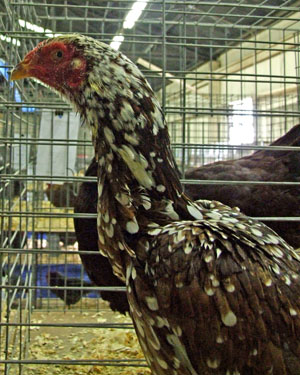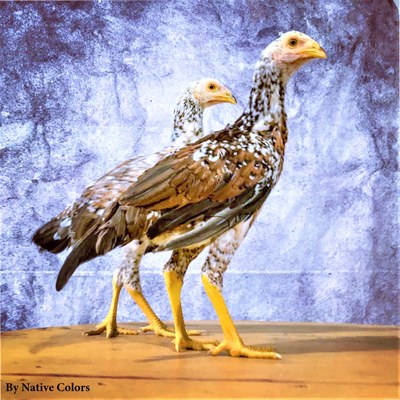Shamo Chickens
 At the beginning of Edo period, the 1600s, the Shamo's ancestors arrived in Japan
from Siam, Thailand. The Japanese selectively bred those birds for strength and endurance
for combat, resulting in the Oriental fighting breed Shamo. The Shamo went on to be
the basis of two domestic breeds: the Yokohama and the Phoenix.
At the beginning of Edo period, the 1600s, the Shamo's ancestors arrived in Japan
from Siam, Thailand. The Japanese selectively bred those birds for strength and endurance
for combat, resulting in the Oriental fighting breed Shamo. The Shamo went on to be
the basis of two domestic breeds: the Yokohama and the Phoenix.
The first documentation of a Shamo outside of Japan was from a German poultry author, Bruno Duringen. According to his record, the first breeding pairs of Shamos came to Germany in March 1884, under ownership of the Countess of Ulm-Erbach. In 1953, a second importation from the Tokyo Zoo to the Hagenback Zoo occurred.
In 1941, to combat the breed's possible extinction, the Japanese government placed the breed under protection of law.
The Shamo’s first foray to America came home with G.I.s after WWII, some as eggs in pockets.
The American Poultry Association recognized the Shamo as a breed in 1981.
 In Southern America, the breed became popular for crossbreeding to produce their fighting
chicken stock. They remain popular today, with the southern states owning the majority
of Shamo chickens in America.
In Southern America, the breed became popular for crossbreeding to produce their fighting
chicken stock. They remain popular today, with the southern states owning the majority
of Shamo chickens in America.
Characteristics
The Shamo has a wide variety of colors and sizes, depending on the region of Japan they hail from.
- The O-Shamo is largest, with males weighing an average of 12.4 lbs, and females 7.5 lbs.
- The Chu-Shamo is more medium-sized, with males of 8 lbs and females of 6 lbs.
- The Kimpa-Shamo is smallest, with 4 lb males and 3 lb females. The Kimpa-Shamo is also hen-feathered, meaning their back-ends have wide, blunt feathers instead of the tails roosters are known for.
The American Poultry Association accepts Shamos as typical in America in three colors: Black, Dark, and Black Breasted Red, and the accepted weights are 11 lbs for males, 7 lbs for females.
The Shamo is a large, tall chicken, typically 30 inches tall, that carries themselves in a nearly vertical position. They have muscled thighs and a wide, muscular body. Their feathers are hard, close to the skin, and they often don't provide complete coverage of the skin, with no feathers on their face or throat. They have pea combs and pearl colored eyes.
They have a friendly temperament to humans, but are very aggressive towards chickens of the same sex. To the point that the chicks of the Shamo fight almost immediately after birth, and the cocks have to be separated before they fight to the death.
The Shamo is a fair to poor egg layer, but they have good maternal instincts.
They are also a poor meat breed, with the meat being very firm and tough, although it was added to many Sumo wrestlers' diets for "pep" in the 19th century.
References
The Livestock Conservancy PO Box 477, 33 Hillsboro St, Pittsboro, NC 27312
